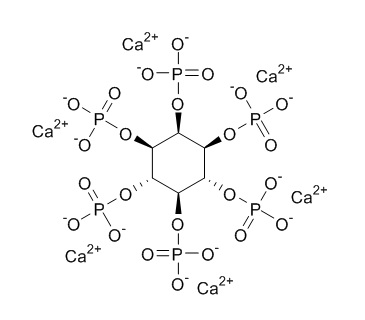Phytin
1. Phytin and magnesium citrate have hypocalciuric effect , they can reduce urinary calcium excretion in rats fed on high-calcium diets.
2. A six-day treatment with phytin can restore the normal level of the liver monooxygenase system components and MMW peptides, also can reduce the level of lactic acid (LA) and increased that of pyruvic acid (PA) in liver tissues, which lead to a sharp drop in the LA/MA ratio indicative of a decrease in the extent of hypoxia.
3. Individually phytin, EDTA and copper (Cu2+) have inhibitory effect on growth of Gram positive as well as Gram negative bacteria, phytin preferentially protects only Gram negative bacteria from Cu 2+ ion toxicity,phytin also has chelating ability.
Inquire / Order:
manager@chemfaces.com
Technical Inquiries:
service@chemfaces.com
Tel:
+86-27-84237783
Fax:
+86-27-84254680
Address:
1 Building, No. 83, CheCheng Rd., Wuhan Economic and Technological Development Zone, Wuhan, Hubei 430056, PRC
Providing storage is as stated on the product vial and the vial is kept tightly sealed, the product can be stored for up to
24 months(2-8C).
Wherever possible, you should prepare and use solutions on the same day. However, if you need to make up stock solutions in advance, we recommend that you store the solution as aliquots in tightly sealed vials at -20C. Generally, these will be useable for up to two weeks. Before use, and prior to opening the vial we recommend that you allow your product to equilibrate to room temperature for at least 1 hour.
Need more advice on solubility, usage and handling? Please email to: service@chemfaces.com
The packaging of the product may have turned upside down during transportation, resulting in the natural compounds adhering to the neck or cap of the vial. take the vial out of its packaging and gently shake to let the compounds fall to the bottom of the vial. for liquid products, centrifuge at 200-500 RPM to gather the liquid at the bottom of the vial. try to avoid loss or contamination during handling.
Phytochemistry.2021, 181:112539.
Environ Toxicol.2024, 39(5):2927-2936.
Oxid Med Cell Longev.2021, 2021:4883398.
Molecules.2024, 29(5):1048.
Buildings2023, 13(5), 1112.
Expert Opin Ther Targets.2024, :1-11.
Nat Commun.2021, 12(1):681.
Mol Microbiol.2019, 112(1):317-332
Heliyon.2023, e12684.
Food and Fermentation Industries2018, 44(371)
Related and Featured Products
Other References Information
World J. Urol., 1994;12(6):323-8.
Effects of magnesium citrate and phytin on reducing urinary calcium excretion in rats.[Pubmed:
7881470]
he aim of this study was to determine and compare the effects of both magnesium citrate and Phytin on reducing urinary calcium excretion under high-calcium-diet conditions during single and combined treatments. An animal experiment was carried out over a period of 4 weeks in 35 male rats. Urinary calcium excretion was reduced significantly by magnesium citrate and/or Phytin in rats fed on high-calcium diets. The hypocalciuric effect of magnesium citrate was more evident than that of Phytin. Urinary magnesium excretion was high in all experimental groups. However, the urinary magnesium/calcium ratios showed a consistent increase only in the groups treated with magnesium citrate. Urinary citrate excretion showed a relative increase with the introduction of magnesium citrate plus Phytin; however, in both the high-calcium-diet group and the magnesium-citrate group this was found to be reduced. Urinary phosphate excretion was slightly higher in the groups treated with Phytin. There was no definite difference in urinary oxalate concentration between the groups. No significant change was noted in the serum concentration of calcium, magnesium, or phosphate.
Eksp. Klin. Farmakol., 2001,64(1):71-3.
[Effect of benzonal on the absorptive-secretory function in the liver of immature rabbits in post-compression period of long-term compression syndrome].[Pubmed:
11558444]
The absorptive-secretory function of hepatocytes using chromodiagnostic test by means of cardiogrin in rabbits at the age of 1 month in postcompression period of prolonged compression syndrome (PCS) was studied. It was established that the given function of hepatocytes was sufficiently and stably depressed for PCS. By effect of inductor of hepatocytes' monooxygenase system benzonal the disorders in parameters of cardiogreen pharmacokinetics are being distinctly removed. The velocity of blood stream in the liver was restored up to a level in health animals. It is supposed that an inclusion of benzonal into a complex of therapeutical remedies allows to enhance an effectiveness in PCS treatment during prepubescent period.
Indian J. Exp. Biol., 1999, 37(6):618-20.
Protection by phytin against Cu~(2+) ion toxicity in few bacteria[Reference:
WebLink]
ndividually Phytin, EDTA and copper (Cu~(2+)) have inhibitory effect on growth of Gram positive as well as Gram negative bacteria. Cu~(2+) has been found to be more toxic to Rhizobium of the four species of bacteria studied. Toxicity of Cu~(2+) is reduced by EDTA. Differential effect of Phytin has been observed between Gram positive and Gram negative bacteria, Phytin preferentially protects only Gram negative bacteria from Cu~(2+) ion toxicity. This has been interpreted that strong electrostatic repulsion between anionic Phytin and anionic biopolymer teichoic acid on the surface of Gram positive bacteria results in inhibition of penetration of Phytin into them. Thus the chelating ability of Phytin, an anionic biomolecule present in many foodstuff, has some beneficial effect too.



